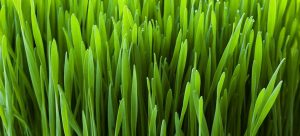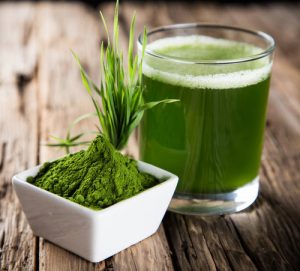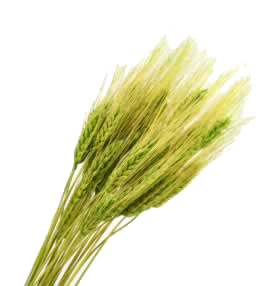Barley
Vitamin & Mineral Supplements
Vs. Whole Foods Nutrition
Most of consumers may be wondering whether, since they intake a multiple vitamin/mineral formula, should green foods would also take part in their consumption? The enzyme-rich live foods found in barley grass are the ones providing vitamins and minerals direct from nature, with all the natural components intact occurring co-factors and synergy. It is merely not possible to just isolate and put into a single vitamin/mineral supplement all of the containing hundreds and possibly thousands of yet to be discovered nutrients found in the whole foods.
Our body is able to identify these foods, easily absorbing and digesting what it needs only and eliminating what it doesn’t from these whole foods and their concentrates that have complete nutritional complexes, otherwise called as “selective absorption”. Potential environment of bio-chemical imbalances and toxicities happen on most vitamin and mineral supplements that are made from fractionated, isolated, or synthetic sources that leaves our body no option but to deal with these incomplete substances.
Benefits of Barley Grass
Barley grass is one of the green grasses. In which intrinsic nature of barley is found in the leaves, the young green shoots of power that form before the grain. The ones that have tremendous ability in absorbing nutrients from the soil are the young leaves. When barley leaves will contain all the vitamins, minerals, and proteins needed for the human diet, plus chlorophyll upon reaching 12-14 inches in height. These requirements by the human body are easily absorbed and digested throughout the digestive tract, that give our bodies easy access to essential nutrients.
The vitamins and minerals that are found in green barley (Barley Greens) leaves are in large amounts. These include calcium, potassium, iron, magnesium, copper, phosphorus, zinc, manganese, beta carotene, B1, B2, B6, C, pantothenic acid and folic acid. The amount of calcium found in cow’s milk is only 11 times less only than what can be found in barley grass which is said even to have vitamin B1 that is 30 times more on it, nearly 5 times the iron content of spinach, 6.5 times as much carotene, roughly seven times the vitamin C in oranges that has 80 micrograms of vitamin B12 per 100 grams of dried barley plant juice and four times more the vitamin B1 that can be found in whole wheat flour.
 Barley grass has very high content of organic sodium that dissolves calcium being deposited on the joints and also restores organic sodium in the stomach lining, helps in digestion which improves the production of hydrochloric acid in the stomach. People that have arthritis used celery juice for many years due to the organic sodium that it contains (28mg per 100grms), and yet the amount of organic sodium in barley grass is even (775mg per 100 grams)!
Barley grass has very high content of organic sodium that dissolves calcium being deposited on the joints and also restores organic sodium in the stomach lining, helps in digestion which improves the production of hydrochloric acid in the stomach. People that have arthritis used celery juice for many years due to the organic sodium that it contains (28mg per 100grms), and yet the amount of organic sodium in barley grass is even (775mg per 100 grams)!
Barley grass has about 45 percent protein during harvest to make juice. It has protein content doubled done what can be found on an equivalent amount of wheat germ and about five times the minerals found in an animal protein, given that the protein in barley grass is fatless.
Enzymes which are important body regulators are believed to have contained up to 1,000 of them on barley grass. These are essentials in order the cells of our body to function properly and we would not perish. Barley grass has SOD (superoxide dismutase), one of the highest natural levels of enzyme which is a powerful antioxidant protecting the cells against free radicals that are toxic, believed to be prime reason that speeds up aging in humans.
Amongst the contents of barley grass is one of the most amazing nutrients: chlorophyll, which naturally detoxifies the intestines in getting rid of stored toxins. It is not necessary that you have to drink juices extracted from green grass to get chlorophyll; it is naturally present in all dark green, leafy vegetables. But here’s the popping question “how many servings of spinach, collards, kale, turnip, mustard greens and beet tops, do you actually eat every day?” And for those who are including them on their daily consumptions, there is, however, a limit to the amount of spinach, turnip and the likes we only have to consume daily.
Importance of green foods
 In our diet the essential of green foods consumption is now being proven scientifically. In respect to both nutrients and cost, dehydrated cereal grasses compare favorably with other greens. It is indeed an excellent and convenient source of green food nutrients.
In our diet the essential of green foods consumption is now being proven scientifically. In respect to both nutrients and cost, dehydrated cereal grasses compare favorably with other greens. It is indeed an excellent and convenient source of green food nutrients.
Healthy blood and circulation is being supported by green food nutrients with Iron, vitamin C, vitamin B12, folic acid, pyridoxine and protein that are all important for the formation and maintenance of enough levels of hemoglobin and red blood cells. In which chlorophyll may also be essential in these processes. Moreover, chlorophyll, calcium and vitamin K all contribute in blood clot formation and breakdown.
Users of barley grass have also experience it being helpful in losing some extra pounds and good for the heart, aid in correcting blood sugar problems, healing of ulcers and, more importantly, as a general tonic.
Amino Acids and Proteins in Barley Grass
Amino acids, the building blocks of proteins, 20 of them are present in the body proteins in sufficient quality. Proteins are the major component of every cell and body fluid (excluding urine and bile) and are thus required for the continual building of cells, regeneration, and energy production that are essentials in life. Additional benefit of the Barley Grass leaf proteins is that they are polypeptide, meaning they are smaller proteins that can be directly absorbed by the blood, where they promote metabolism of cells, the changes of chemicals in human body that we need to live and counterbalance substances that are harmful to our health. Barley Grass 18 amino acids contents (including the 8 essential amino acids) – which are the amino acids that we must obtain from our diets; where the body cannot produce them alone.
Alkalinity and More
 Barley Grass leaves is extremely alkaline, so when digested by the body it helps to keep the body’s alkalinity and acid ratio in harmony. Our cells cannot function properly if the pH range (the one that measures alkaline and acidity) is not in a very restricted level. Generally processed foods are acidic, and when we have consumed them in bulk, the acidity/alkaline balance is sacrificed. This will result in fatigue more often.
Barley Grass leaves is extremely alkaline, so when digested by the body it helps to keep the body’s alkalinity and acid ratio in harmony. Our cells cannot function properly if the pH range (the one that measures alkaline and acidity) is not in a very restricted level. Generally processed foods are acidic, and when we have consumed them in bulk, the acidity/alkaline balance is sacrificed. This will result in fatigue more often.
Recent research has shown a huge other possible benefits of Barley Grass. Extracted compounds have been tested to have hypercholesterolemic, anti-ulcer and anti-inflammatory properties. A recently discovered antioxidant, 2″-0-GIV, has been separated from the group and found out to have antioxidant activity equal to or superior to vitamin E. Furthermore, studies have shown that when Barley Grass juice is added to damage cells, the cells’ DNA repairs themselves more quickly. This may be a contributing factor in the prevention of the changes that often lead to cancer, cell death and rapid aging.
The Medicinal Benefits of Barley Grass Powder
Credit to “Barley Grass”, by Betsy Block, NATURAL HEALTH Magazine – Oct 1999 pg. 44
WHAT IT IS – Barley grass (Hordeum vulgare) is the seedling of the barley plant. It is normally harvested in roughly 200 days after germination, when the shoots are less than a foot tall.
NUTRITIONAL VALUE – This is condensed with about three dozen vitamins and minerals, barley grass is absolutely rich in vitamins A, C, B1, B2, and B12, folic acid, calcium, potassium, iron and chlorophyll. Not similar to most plants, barley grass is an excellent source of all nine essential amino acids (those which can’t be produced by the human body).
HEALING CLAIMS – Barley grass is an amazing antioxidant that is observed to help the body overcome a variety of ailments, including acne and ulcers and kill cancer cells.
HOW IT WORKS – An antioxidant called alpha tocopherol succinate – an influential relative of vitamin E (alpha-tocopherol) is said to be the one responsible for much of the plant’s anti-tumor effect on the body, according to Allan L. Goldstein, Ph.D., head of the biochemistry department at George Washington University’s School of Medicine and Health Sciences in Washington, D.C., who has studied barley grass. Though its mechanism is unknown, alpha-tocopherol succinate seems to prevent many types of cancer that include leukemia, prostate cancer and brain tumors.
 According to Yoshihide Hagiwara, M.D., a researcher in Japan and author of the book “Green Barley Essence” (Keats, 1985), barley grass aids in the cure of skin diseases and ulcers by stimulating the growth of new cells. It is yet to be figured out still how exactly this happens, indeed barley grass is high in chlorophyll, an antibacterial green pigment.
According to Yoshihide Hagiwara, M.D., a researcher in Japan and author of the book “Green Barley Essence” (Keats, 1985), barley grass aids in the cure of skin diseases and ulcers by stimulating the growth of new cells. It is yet to be figured out still how exactly this happens, indeed barley grass is high in chlorophyll, an antibacterial green pigment.
THE EVIDENCE – There are no clinical trials yet have been conducted for barley grass. In an experiment conducted at George Washington University by Goldstein and his colleagues through exposing leukemic cancer cells to dehydrated barley grass extract. The extract killed virtually all of them. Encouraged, the researchers then exposed brain cancer cells to the extract. It destroyed 30 to 50 percent of these cells. In a third trial, the extract restrains the growth of three types of prostate cancer cells by 90 to 100 percent. Compare Curing Massive Cancer With Green Barley Pills.
In Japan, where barley grass extract is famous, there is anecdotal proof that it aids the body heal from many different illnesses. In one informal study, a Japanese dermatologist observed a group of 7.5 patients having skin diseases that range from melanosis (darkening of the skin) to eczema. The patients who in take barley grass extract healed much quicker than those who did not. There has been noticeable increase also in appetite and bowel regularity.
